Interpersonal Communication in Healthcare | Nursing Portfolio
VerifiedAdded on 2022/08/11
|13
|3209
|25
AI Summary
Contribute Materials
Your contribution can guide someone’s learning journey. Share your
documents today.
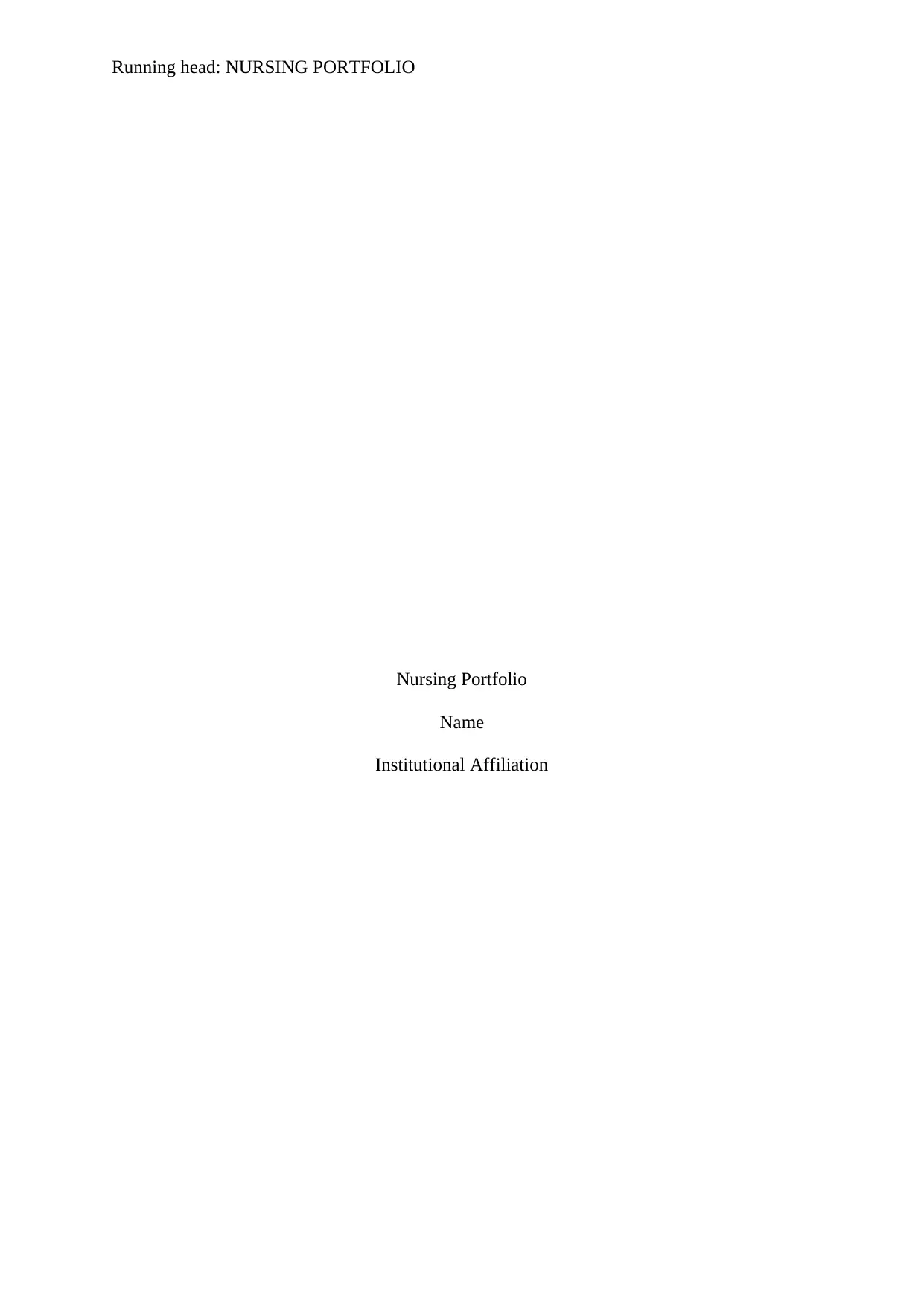
Running head: NURSING PORTFOLIO
Nursing Portfolio
Name
Institutional Affiliation
Nursing Portfolio
Name
Institutional Affiliation
Secure Best Marks with AI Grader
Need help grading? Try our AI Grader for instant feedback on your assignments.
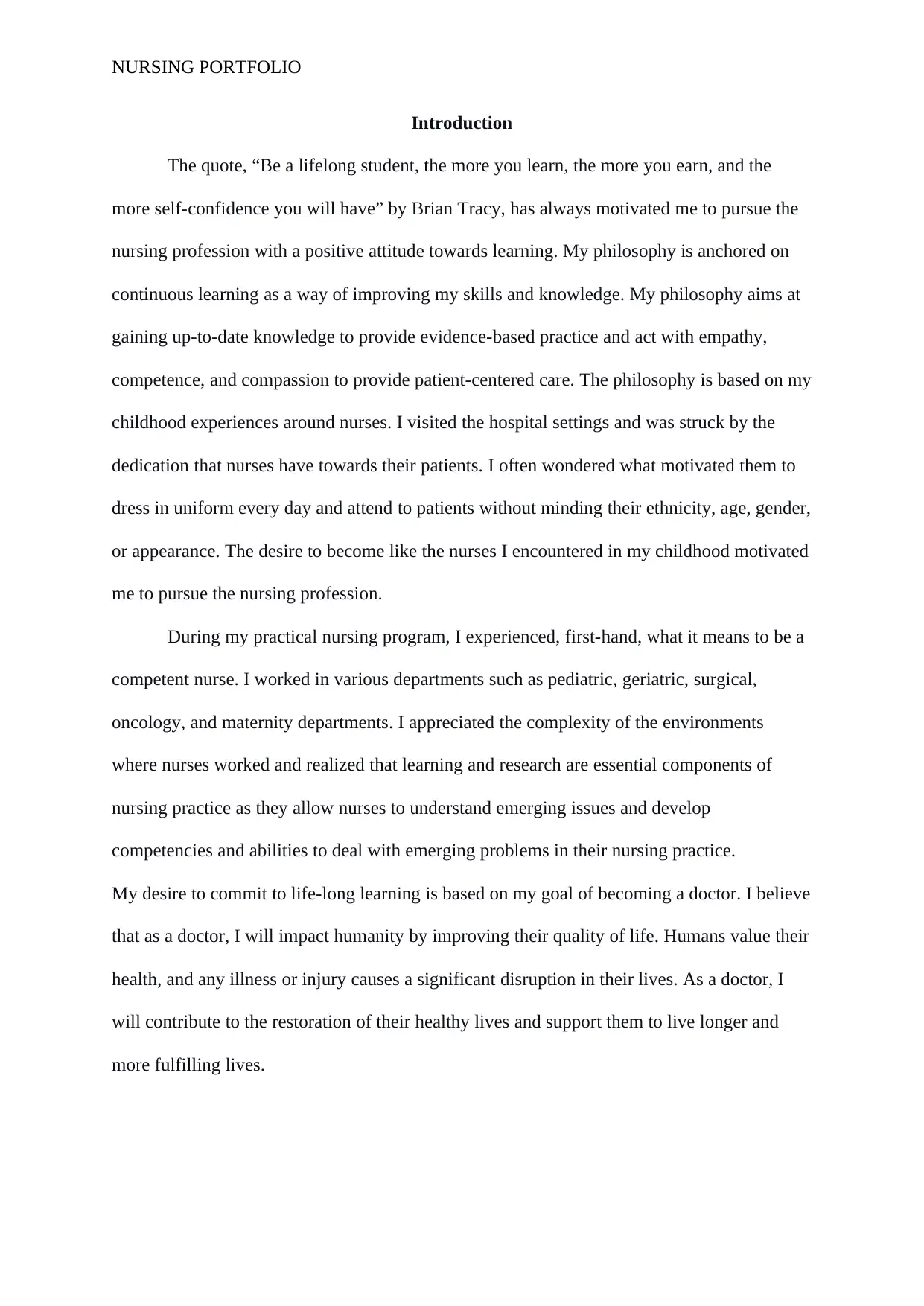
NURSING PORTFOLIO
Introduction
The quote, “Be a lifelong student, the more you learn, the more you earn, and the
more self-confidence you will have” by Brian Tracy, has always motivated me to pursue the
nursing profession with a positive attitude towards learning. My philosophy is anchored on
continuous learning as a way of improving my skills and knowledge. My philosophy aims at
gaining up-to-date knowledge to provide evidence-based practice and act with empathy,
competence, and compassion to provide patient-centered care. The philosophy is based on my
childhood experiences around nurses. I visited the hospital settings and was struck by the
dedication that nurses have towards their patients. I often wondered what motivated them to
dress in uniform every day and attend to patients without minding their ethnicity, age, gender,
or appearance. The desire to become like the nurses I encountered in my childhood motivated
me to pursue the nursing profession.
During my practical nursing program, I experienced, first-hand, what it means to be a
competent nurse. I worked in various departments such as pediatric, geriatric, surgical,
oncology, and maternity departments. I appreciated the complexity of the environments
where nurses worked and realized that learning and research are essential components of
nursing practice as they allow nurses to understand emerging issues and develop
competencies and abilities to deal with emerging problems in their nursing practice.
My desire to commit to life-long learning is based on my goal of becoming a doctor. I believe
that as a doctor, I will impact humanity by improving their quality of life. Humans value their
health, and any illness or injury causes a significant disruption in their lives. As a doctor, I
will contribute to the restoration of their healthy lives and support them to live longer and
more fulfilling lives.
Introduction
The quote, “Be a lifelong student, the more you learn, the more you earn, and the
more self-confidence you will have” by Brian Tracy, has always motivated me to pursue the
nursing profession with a positive attitude towards learning. My philosophy is anchored on
continuous learning as a way of improving my skills and knowledge. My philosophy aims at
gaining up-to-date knowledge to provide evidence-based practice and act with empathy,
competence, and compassion to provide patient-centered care. The philosophy is based on my
childhood experiences around nurses. I visited the hospital settings and was struck by the
dedication that nurses have towards their patients. I often wondered what motivated them to
dress in uniform every day and attend to patients without minding their ethnicity, age, gender,
or appearance. The desire to become like the nurses I encountered in my childhood motivated
me to pursue the nursing profession.
During my practical nursing program, I experienced, first-hand, what it means to be a
competent nurse. I worked in various departments such as pediatric, geriatric, surgical,
oncology, and maternity departments. I appreciated the complexity of the environments
where nurses worked and realized that learning and research are essential components of
nursing practice as they allow nurses to understand emerging issues and develop
competencies and abilities to deal with emerging problems in their nursing practice.
My desire to commit to life-long learning is based on my goal of becoming a doctor. I believe
that as a doctor, I will impact humanity by improving their quality of life. Humans value their
health, and any illness or injury causes a significant disruption in their lives. As a doctor, I
will contribute to the restoration of their healthy lives and support them to live longer and
more fulfilling lives.
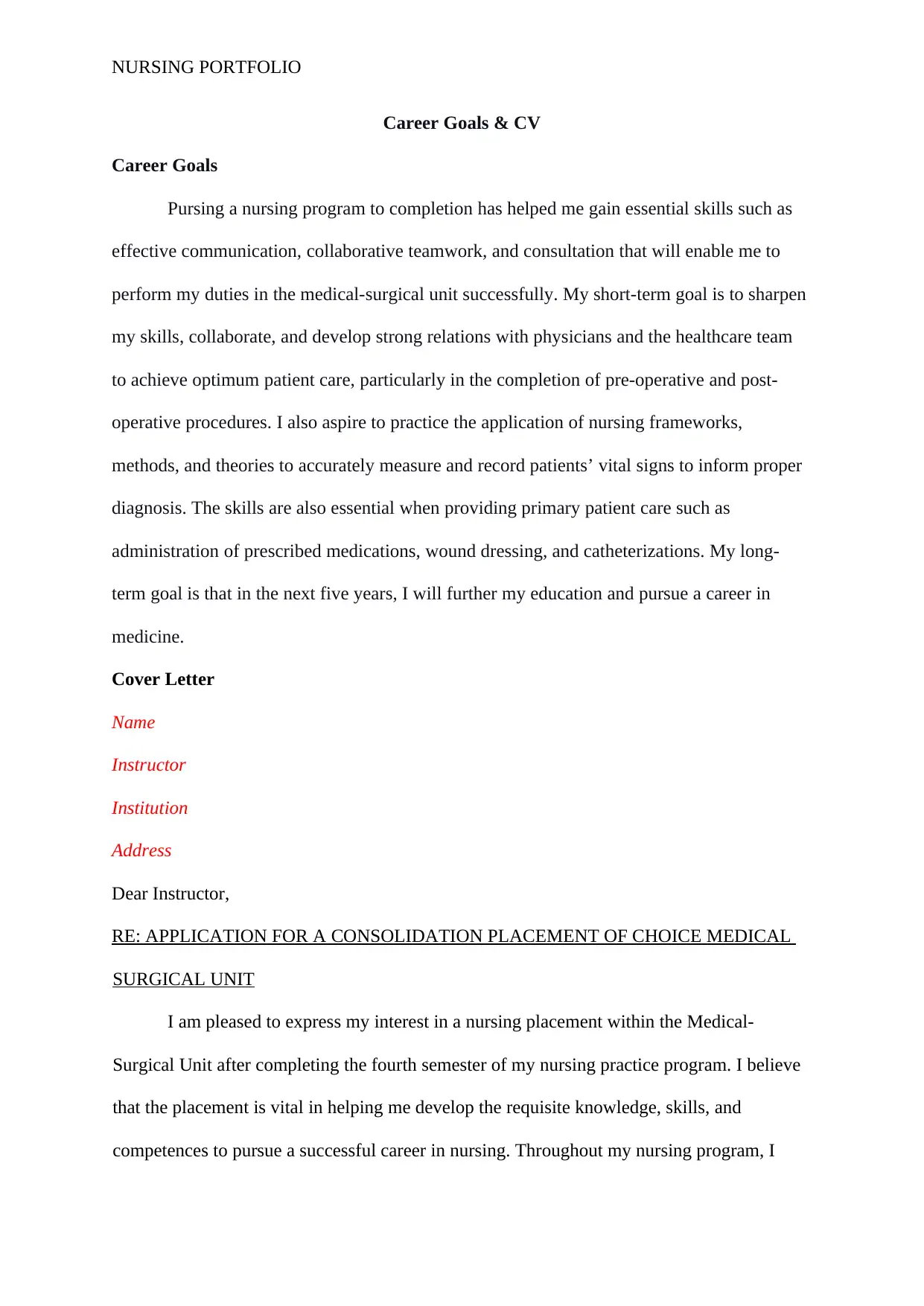
NURSING PORTFOLIO
Career Goals & CV
Career Goals
Pursing a nursing program to completion has helped me gain essential skills such as
effective communication, collaborative teamwork, and consultation that will enable me to
perform my duties in the medical-surgical unit successfully. My short-term goal is to sharpen
my skills, collaborate, and develop strong relations with physicians and the healthcare team
to achieve optimum patient care, particularly in the completion of pre-operative and post-
operative procedures. I also aspire to practice the application of nursing frameworks,
methods, and theories to accurately measure and record patients’ vital signs to inform proper
diagnosis. The skills are also essential when providing primary patient care such as
administration of prescribed medications, wound dressing, and catheterizations. My long-
term goal is that in the next five years, I will further my education and pursue a career in
medicine.
Cover Letter
Name
Instructor
Institution
Address
Dear Instructor,
RE: APPLICATION FOR A CONSOLIDATION PLACEMENT OF CHOICE MEDICAL
SURGICAL UNIT
I am pleased to express my interest in a nursing placement within the Medical-
Surgical Unit after completing the fourth semester of my nursing practice program. I believe
that the placement is vital in helping me develop the requisite knowledge, skills, and
competences to pursue a successful career in nursing. Throughout my nursing program, I
Career Goals & CV
Career Goals
Pursing a nursing program to completion has helped me gain essential skills such as
effective communication, collaborative teamwork, and consultation that will enable me to
perform my duties in the medical-surgical unit successfully. My short-term goal is to sharpen
my skills, collaborate, and develop strong relations with physicians and the healthcare team
to achieve optimum patient care, particularly in the completion of pre-operative and post-
operative procedures. I also aspire to practice the application of nursing frameworks,
methods, and theories to accurately measure and record patients’ vital signs to inform proper
diagnosis. The skills are also essential when providing primary patient care such as
administration of prescribed medications, wound dressing, and catheterizations. My long-
term goal is that in the next five years, I will further my education and pursue a career in
medicine.
Cover Letter
Name
Instructor
Institution
Address
Dear Instructor,
RE: APPLICATION FOR A CONSOLIDATION PLACEMENT OF CHOICE MEDICAL
SURGICAL UNIT
I am pleased to express my interest in a nursing placement within the Medical-
Surgical Unit after completing the fourth semester of my nursing practice program. I believe
that the placement is vital in helping me develop the requisite knowledge, skills, and
competences to pursue a successful career in nursing. Throughout my nursing program, I
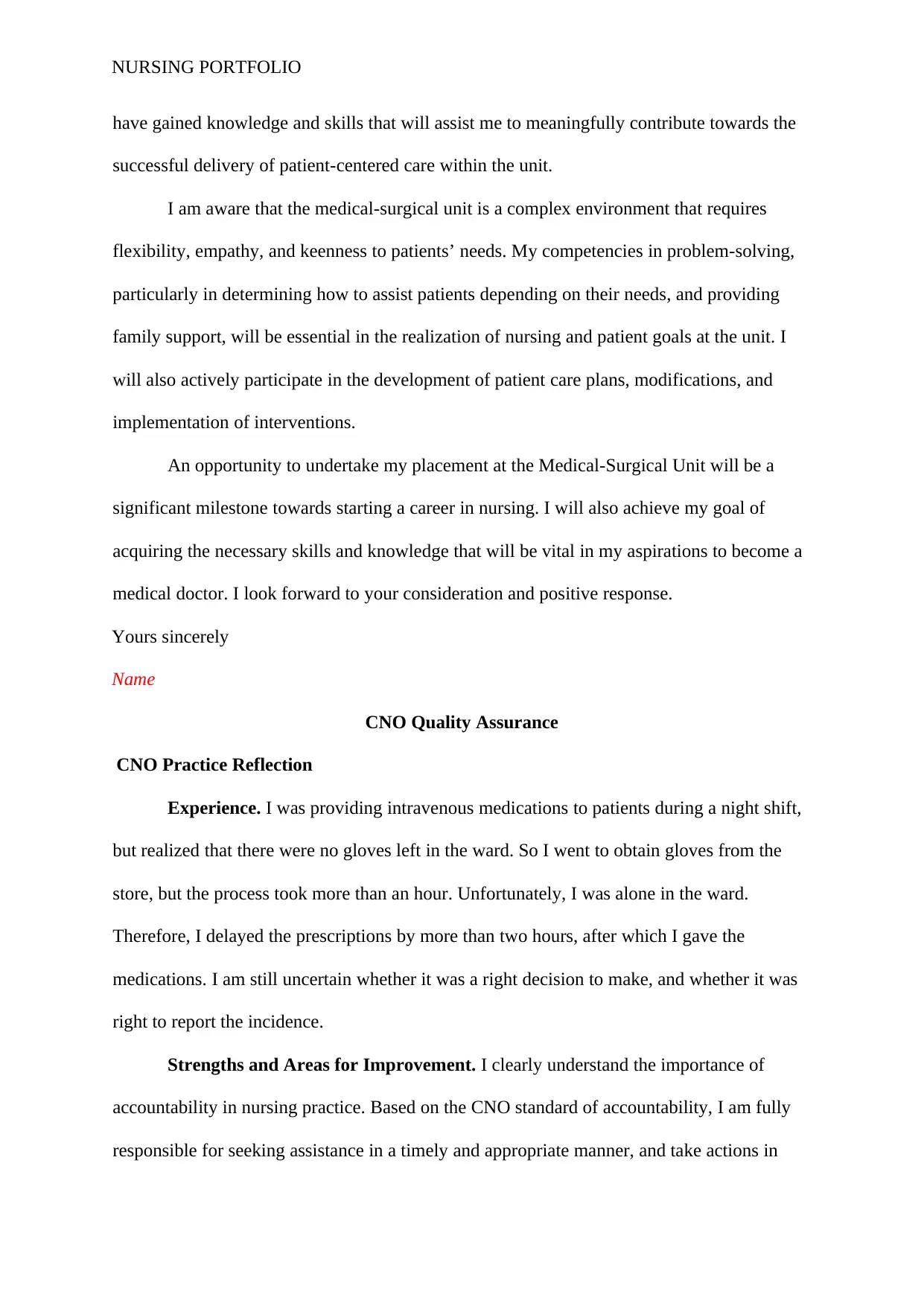
NURSING PORTFOLIO
have gained knowledge and skills that will assist me to meaningfully contribute towards the
successful delivery of patient-centered care within the unit.
I am aware that the medical-surgical unit is a complex environment that requires
flexibility, empathy, and keenness to patients’ needs. My competencies in problem-solving,
particularly in determining how to assist patients depending on their needs, and providing
family support, will be essential in the realization of nursing and patient goals at the unit. I
will also actively participate in the development of patient care plans, modifications, and
implementation of interventions.
An opportunity to undertake my placement at the Medical-Surgical Unit will be a
significant milestone towards starting a career in nursing. I will also achieve my goal of
acquiring the necessary skills and knowledge that will be vital in my aspirations to become a
medical doctor. I look forward to your consideration and positive response.
Yours sincerely
Name
CNO Quality Assurance
CNO Practice Reflection
Experience. I was providing intravenous medications to patients during a night shift,
but realized that there were no gloves left in the ward. So I went to obtain gloves from the
store, but the process took more than an hour. Unfortunately, I was alone in the ward.
Therefore, I delayed the prescriptions by more than two hours, after which I gave the
medications. I am still uncertain whether it was a right decision to make, and whether it was
right to report the incidence.
Strengths and Areas for Improvement. I clearly understand the importance of
accountability in nursing practice. Based on the CNO standard of accountability, I am fully
responsible for seeking assistance in a timely and appropriate manner, and take actions in
have gained knowledge and skills that will assist me to meaningfully contribute towards the
successful delivery of patient-centered care within the unit.
I am aware that the medical-surgical unit is a complex environment that requires
flexibility, empathy, and keenness to patients’ needs. My competencies in problem-solving,
particularly in determining how to assist patients depending on their needs, and providing
family support, will be essential in the realization of nursing and patient goals at the unit. I
will also actively participate in the development of patient care plans, modifications, and
implementation of interventions.
An opportunity to undertake my placement at the Medical-Surgical Unit will be a
significant milestone towards starting a career in nursing. I will also achieve my goal of
acquiring the necessary skills and knowledge that will be vital in my aspirations to become a
medical doctor. I look forward to your consideration and positive response.
Yours sincerely
Name
CNO Quality Assurance
CNO Practice Reflection
Experience. I was providing intravenous medications to patients during a night shift,
but realized that there were no gloves left in the ward. So I went to obtain gloves from the
store, but the process took more than an hour. Unfortunately, I was alone in the ward.
Therefore, I delayed the prescriptions by more than two hours, after which I gave the
medications. I am still uncertain whether it was a right decision to make, and whether it was
right to report the incidence.
Strengths and Areas for Improvement. I clearly understand the importance of
accountability in nursing practice. Based on the CNO standard of accountability, I am fully
responsible for seeking assistance in a timely and appropriate manner, and take actions in
Secure Best Marks with AI Grader
Need help grading? Try our AI Grader for instant feedback on your assignments.
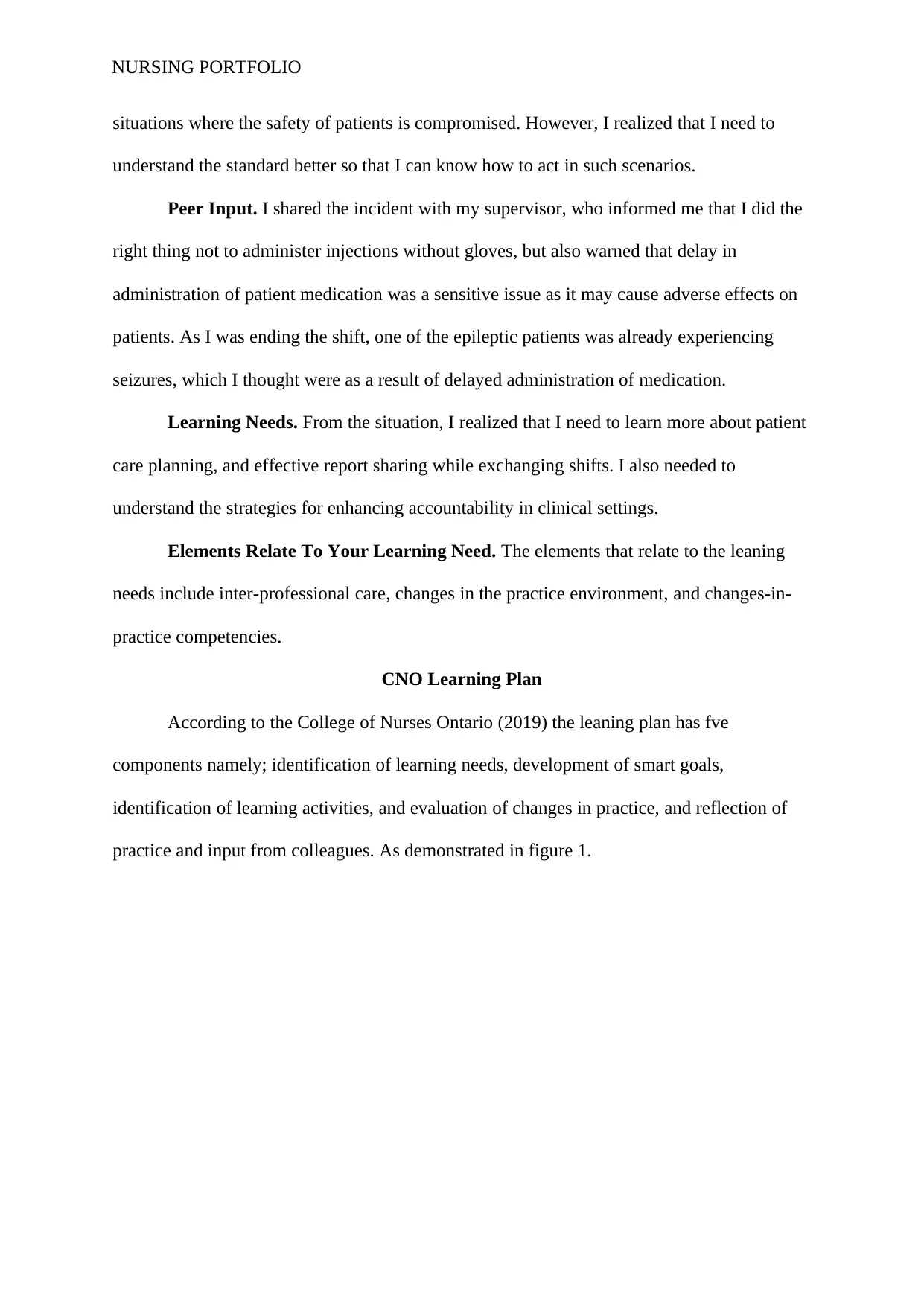
NURSING PORTFOLIO
situations where the safety of patients is compromised. However, I realized that I need to
understand the standard better so that I can know how to act in such scenarios.
Peer Input. I shared the incident with my supervisor, who informed me that I did the
right thing not to administer injections without gloves, but also warned that delay in
administration of patient medication was a sensitive issue as it may cause adverse effects on
patients. As I was ending the shift, one of the epileptic patients was already experiencing
seizures, which I thought were as a result of delayed administration of medication.
Learning Needs. From the situation, I realized that I need to learn more about patient
care planning, and effective report sharing while exchanging shifts. I also needed to
understand the strategies for enhancing accountability in clinical settings.
Elements Relate To Your Learning Need. The elements that relate to the leaning
needs include inter-professional care, changes in the practice environment, and changes-in-
practice competencies.
CNO Learning Plan
According to the College of Nurses Ontario (2019) the leaning plan has fve
components namely; identification of learning needs, development of smart goals,
identification of learning activities, and evaluation of changes in practice, and reflection of
practice and input from colleagues. As demonstrated in figure 1.
situations where the safety of patients is compromised. However, I realized that I need to
understand the standard better so that I can know how to act in such scenarios.
Peer Input. I shared the incident with my supervisor, who informed me that I did the
right thing not to administer injections without gloves, but also warned that delay in
administration of patient medication was a sensitive issue as it may cause adverse effects on
patients. As I was ending the shift, one of the epileptic patients was already experiencing
seizures, which I thought were as a result of delayed administration of medication.
Learning Needs. From the situation, I realized that I need to learn more about patient
care planning, and effective report sharing while exchanging shifts. I also needed to
understand the strategies for enhancing accountability in clinical settings.
Elements Relate To Your Learning Need. The elements that relate to the leaning
needs include inter-professional care, changes in the practice environment, and changes-in-
practice competencies.
CNO Learning Plan
According to the College of Nurses Ontario (2019) the leaning plan has fve
components namely; identification of learning needs, development of smart goals,
identification of learning activities, and evaluation of changes in practice, and reflection of
practice and input from colleagues. As demonstrated in figure 1.
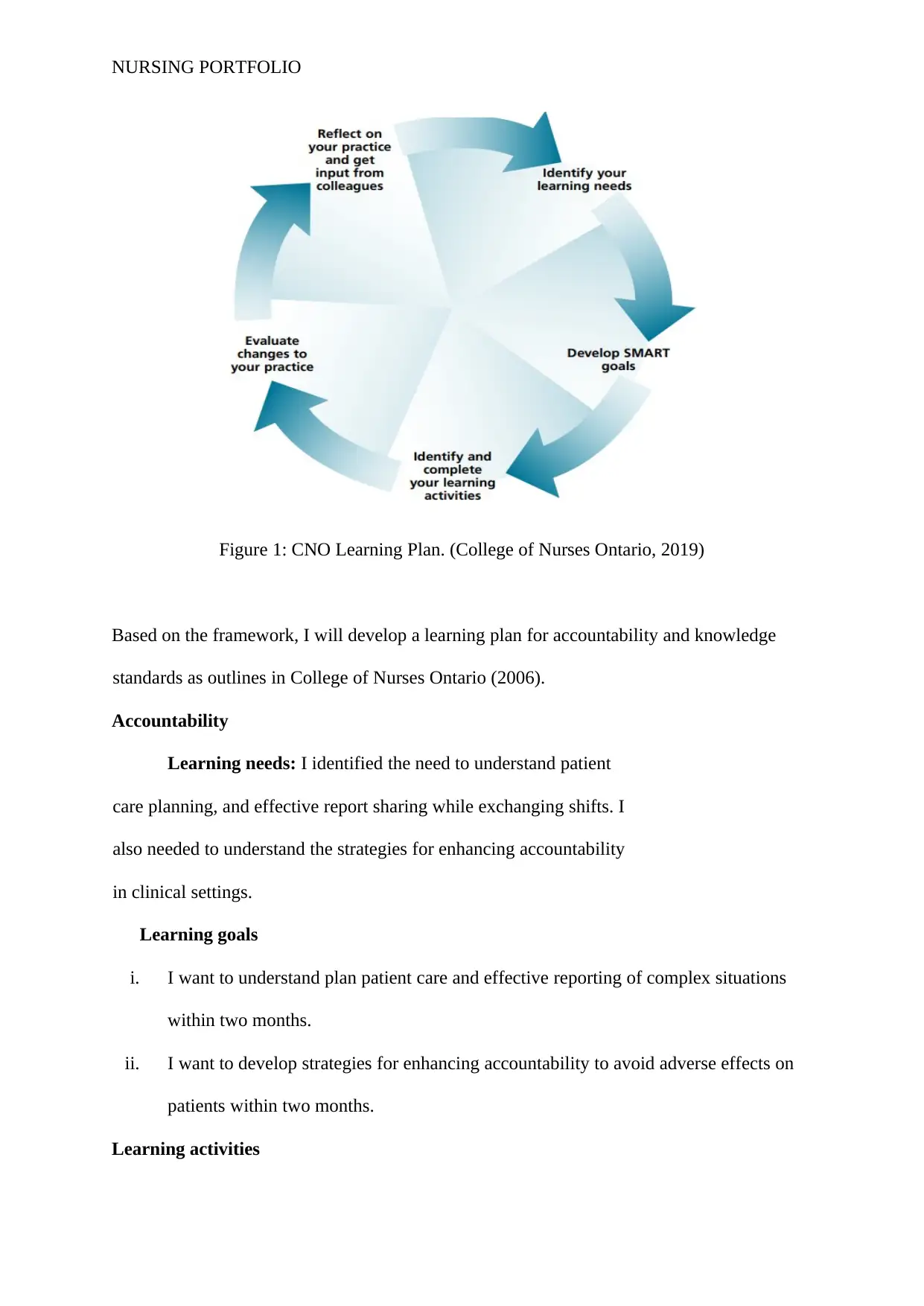
NURSING PORTFOLIO
Figure 1: CNO Learning Plan. (College of Nurses Ontario, 2019)
Based on the framework, I will develop a learning plan for accountability and knowledge
standards as outlines in College of Nurses Ontario (2006).
Accountability
Learning needs: I identified the need to understand patient
care planning, and effective report sharing while exchanging shifts. I
also needed to understand the strategies for enhancing accountability
in clinical settings.
Learning goals
i. I want to understand plan patient care and effective reporting of complex situations
within two months.
ii. I want to develop strategies for enhancing accountability to avoid adverse effects on
patients within two months.
Learning activities
Figure 1: CNO Learning Plan. (College of Nurses Ontario, 2019)
Based on the framework, I will develop a learning plan for accountability and knowledge
standards as outlines in College of Nurses Ontario (2006).
Accountability
Learning needs: I identified the need to understand patient
care planning, and effective report sharing while exchanging shifts. I
also needed to understand the strategies for enhancing accountability
in clinical settings.
Learning goals
i. I want to understand plan patient care and effective reporting of complex situations
within two months.
ii. I want to develop strategies for enhancing accountability to avoid adverse effects on
patients within two months.
Learning activities
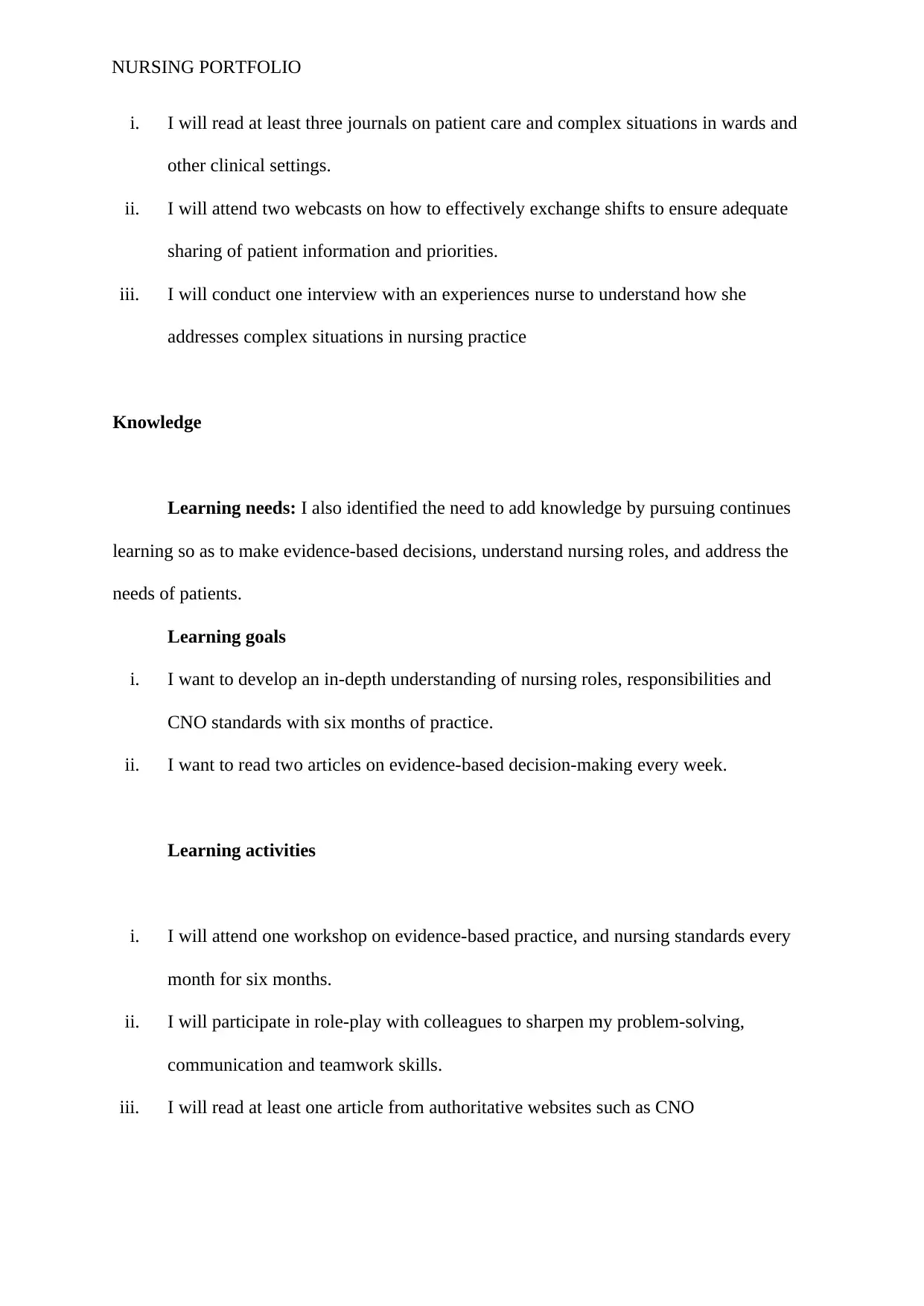
NURSING PORTFOLIO
i. I will read at least three journals on patient care and complex situations in wards and
other clinical settings.
ii. I will attend two webcasts on how to effectively exchange shifts to ensure adequate
sharing of patient information and priorities.
iii. I will conduct one interview with an experiences nurse to understand how she
addresses complex situations in nursing practice
Knowledge
Learning needs: I also identified the need to add knowledge by pursuing continues
learning so as to make evidence-based decisions, understand nursing roles, and address the
needs of patients.
Learning goals
i. I want to develop an in-depth understanding of nursing roles, responsibilities and
CNO standards with six months of practice.
ii. I want to read two articles on evidence-based decision-making every week.
Learning activities
i. I will attend one workshop on evidence-based practice, and nursing standards every
month for six months.
ii. I will participate in role-play with colleagues to sharpen my problem-solving,
communication and teamwork skills.
iii. I will read at least one article from authoritative websites such as CNO
i. I will read at least three journals on patient care and complex situations in wards and
other clinical settings.
ii. I will attend two webcasts on how to effectively exchange shifts to ensure adequate
sharing of patient information and priorities.
iii. I will conduct one interview with an experiences nurse to understand how she
addresses complex situations in nursing practice
Knowledge
Learning needs: I also identified the need to add knowledge by pursuing continues
learning so as to make evidence-based decisions, understand nursing roles, and address the
needs of patients.
Learning goals
i. I want to develop an in-depth understanding of nursing roles, responsibilities and
CNO standards with six months of practice.
ii. I want to read two articles on evidence-based decision-making every week.
Learning activities
i. I will attend one workshop on evidence-based practice, and nursing standards every
month for six months.
ii. I will participate in role-play with colleagues to sharpen my problem-solving,
communication and teamwork skills.
iii. I will read at least one article from authoritative websites such as CNO
Paraphrase This Document
Need a fresh take? Get an instant paraphrase of this document with our AI Paraphraser
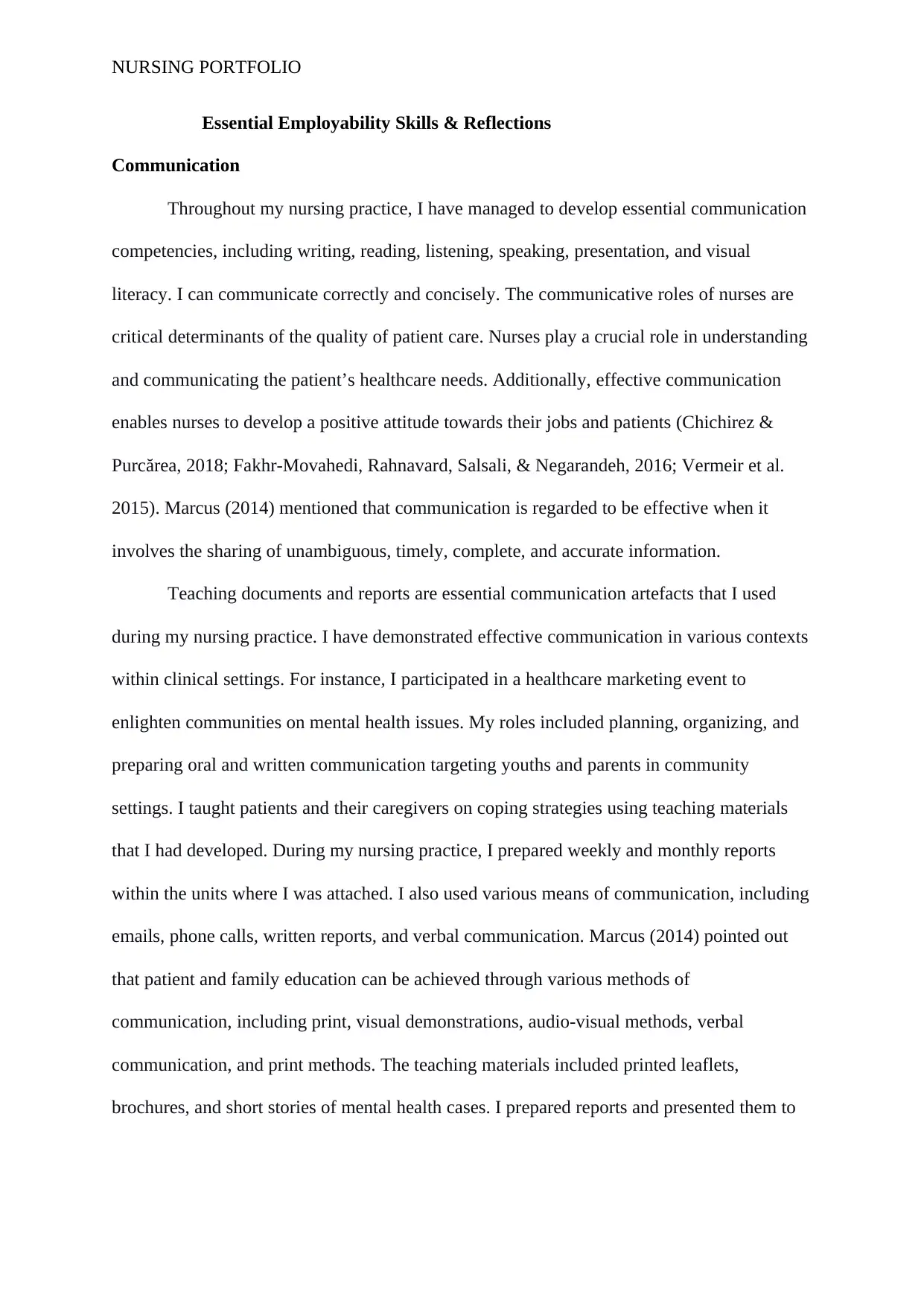
NURSING PORTFOLIO
Essential Employability Skills & Reflections
Communication
Throughout my nursing practice, I have managed to develop essential communication
competencies, including writing, reading, listening, speaking, presentation, and visual
literacy. I can communicate correctly and concisely. The communicative roles of nurses are
critical determinants of the quality of patient care. Nurses play a crucial role in understanding
and communicating the patient’s healthcare needs. Additionally, effective communication
enables nurses to develop a positive attitude towards their jobs and patients (Chichirez &
Purcărea, 2018; Fakhr-Movahedi, Rahnavard, Salsali, & Negarandeh, 2016; Vermeir et al.
2015). Marcus (2014) mentioned that communication is regarded to be effective when it
involves the sharing of unambiguous, timely, complete, and accurate information.
Teaching documents and reports are essential communication artefacts that I used
during my nursing practice. I have demonstrated effective communication in various contexts
within clinical settings. For instance, I participated in a healthcare marketing event to
enlighten communities on mental health issues. My roles included planning, organizing, and
preparing oral and written communication targeting youths and parents in community
settings. I taught patients and their caregivers on coping strategies using teaching materials
that I had developed. During my nursing practice, I prepared weekly and monthly reports
within the units where I was attached. I also used various means of communication, including
emails, phone calls, written reports, and verbal communication. Marcus (2014) pointed out
that patient and family education can be achieved through various methods of
communication, including print, visual demonstrations, audio-visual methods, verbal
communication, and print methods. The teaching materials included printed leaflets,
brochures, and short stories of mental health cases. I prepared reports and presented them to
Essential Employability Skills & Reflections
Communication
Throughout my nursing practice, I have managed to develop essential communication
competencies, including writing, reading, listening, speaking, presentation, and visual
literacy. I can communicate correctly and concisely. The communicative roles of nurses are
critical determinants of the quality of patient care. Nurses play a crucial role in understanding
and communicating the patient’s healthcare needs. Additionally, effective communication
enables nurses to develop a positive attitude towards their jobs and patients (Chichirez &
Purcărea, 2018; Fakhr-Movahedi, Rahnavard, Salsali, & Negarandeh, 2016; Vermeir et al.
2015). Marcus (2014) mentioned that communication is regarded to be effective when it
involves the sharing of unambiguous, timely, complete, and accurate information.
Teaching documents and reports are essential communication artefacts that I used
during my nursing practice. I have demonstrated effective communication in various contexts
within clinical settings. For instance, I participated in a healthcare marketing event to
enlighten communities on mental health issues. My roles included planning, organizing, and
preparing oral and written communication targeting youths and parents in community
settings. I taught patients and their caregivers on coping strategies using teaching materials
that I had developed. During my nursing practice, I prepared weekly and monthly reports
within the units where I was attached. I also used various means of communication, including
emails, phone calls, written reports, and verbal communication. Marcus (2014) pointed out
that patient and family education can be achieved through various methods of
communication, including print, visual demonstrations, audio-visual methods, verbal
communication, and print methods. The teaching materials included printed leaflets,
brochures, and short stories of mental health cases. I prepared reports and presented them to
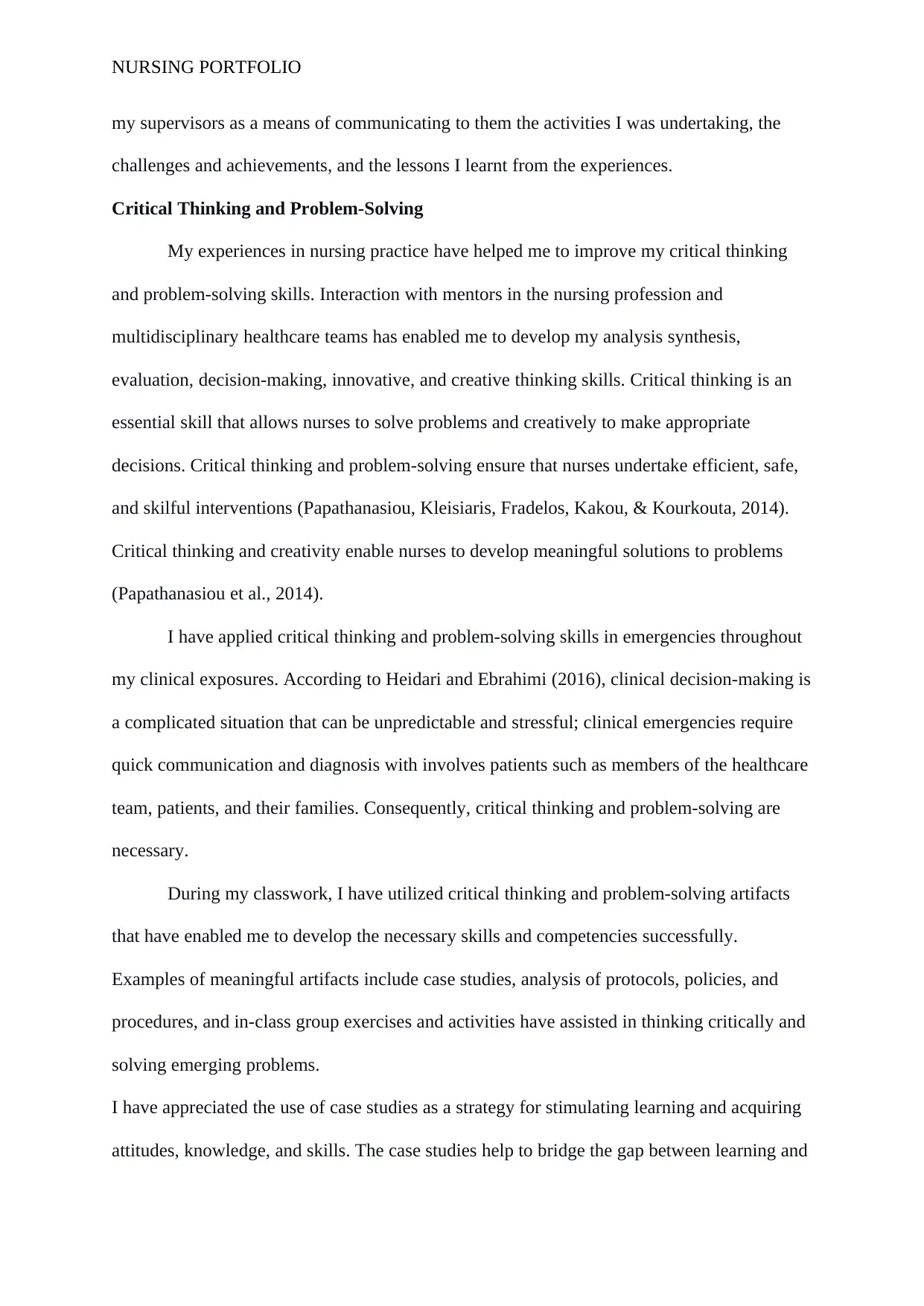
NURSING PORTFOLIO
my supervisors as a means of communicating to them the activities I was undertaking, the
challenges and achievements, and the lessons I learnt from the experiences.
Critical Thinking and Problem-Solving
My experiences in nursing practice have helped me to improve my critical thinking
and problem-solving skills. Interaction with mentors in the nursing profession and
multidisciplinary healthcare teams has enabled me to develop my analysis synthesis,
evaluation, decision-making, innovative, and creative thinking skills. Critical thinking is an
essential skill that allows nurses to solve problems and creatively to make appropriate
decisions. Critical thinking and problem-solving ensure that nurses undertake efficient, safe,
and skilful interventions (Papathanasiou, Kleisiaris, Fradelos, Kakou, & Kourkouta, 2014).
Critical thinking and creativity enable nurses to develop meaningful solutions to problems
(Papathanasiou et al., 2014).
I have applied critical thinking and problem-solving skills in emergencies throughout
my clinical exposures. According to Heidari and Ebrahimi (2016), clinical decision-making is
a complicated situation that can be unpredictable and stressful; clinical emergencies require
quick communication and diagnosis with involves patients such as members of the healthcare
team, patients, and their families. Consequently, critical thinking and problem-solving are
necessary.
During my classwork, I have utilized critical thinking and problem-solving artifacts
that have enabled me to develop the necessary skills and competencies successfully.
Examples of meaningful artifacts include case studies, analysis of protocols, policies, and
procedures, and in-class group exercises and activities have assisted in thinking critically and
solving emerging problems.
I have appreciated the use of case studies as a strategy for stimulating learning and acquiring
attitudes, knowledge, and skills. The case studies help to bridge the gap between learning and
my supervisors as a means of communicating to them the activities I was undertaking, the
challenges and achievements, and the lessons I learnt from the experiences.
Critical Thinking and Problem-Solving
My experiences in nursing practice have helped me to improve my critical thinking
and problem-solving skills. Interaction with mentors in the nursing profession and
multidisciplinary healthcare teams has enabled me to develop my analysis synthesis,
evaluation, decision-making, innovative, and creative thinking skills. Critical thinking is an
essential skill that allows nurses to solve problems and creatively to make appropriate
decisions. Critical thinking and problem-solving ensure that nurses undertake efficient, safe,
and skilful interventions (Papathanasiou, Kleisiaris, Fradelos, Kakou, & Kourkouta, 2014).
Critical thinking and creativity enable nurses to develop meaningful solutions to problems
(Papathanasiou et al., 2014).
I have applied critical thinking and problem-solving skills in emergencies throughout
my clinical exposures. According to Heidari and Ebrahimi (2016), clinical decision-making is
a complicated situation that can be unpredictable and stressful; clinical emergencies require
quick communication and diagnosis with involves patients such as members of the healthcare
team, patients, and their families. Consequently, critical thinking and problem-solving are
necessary.
During my classwork, I have utilized critical thinking and problem-solving artifacts
that have enabled me to develop the necessary skills and competencies successfully.
Examples of meaningful artifacts include case studies, analysis of protocols, policies, and
procedures, and in-class group exercises and activities have assisted in thinking critically and
solving emerging problems.
I have appreciated the use of case studies as a strategy for stimulating learning and acquiring
attitudes, knowledge, and skills. The case studies help to bridge the gap between learning and
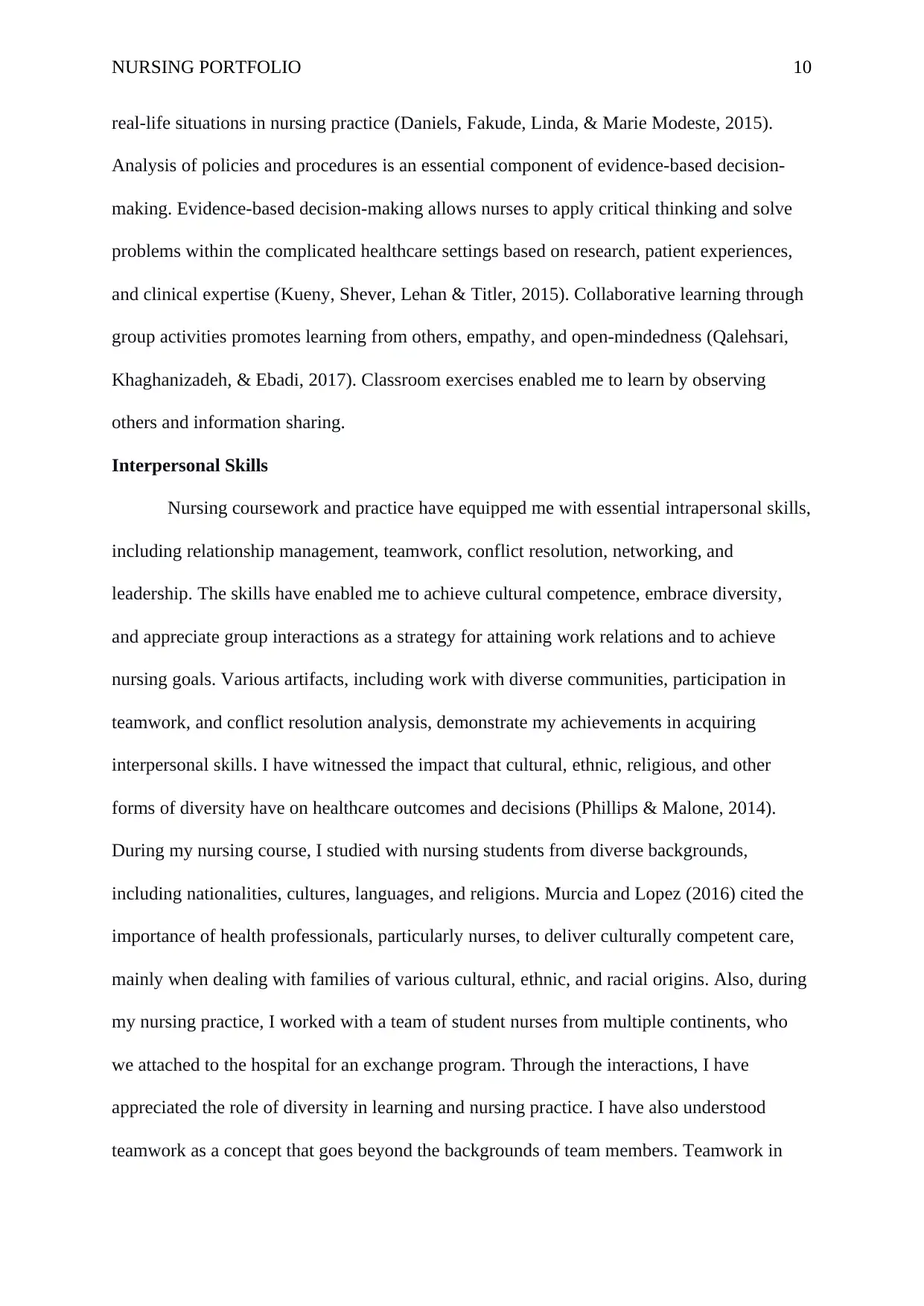
NURSING PORTFOLIO 10
real-life situations in nursing practice (Daniels, Fakude, Linda, & Marie Modeste, 2015).
Analysis of policies and procedures is an essential component of evidence-based decision-
making. Evidence-based decision-making allows nurses to apply critical thinking and solve
problems within the complicated healthcare settings based on research, patient experiences,
and clinical expertise (Kueny, Shever, Lehan & Titler, 2015). Collaborative learning through
group activities promotes learning from others, empathy, and open-mindedness (Qalehsari,
Khaghanizadeh, & Ebadi, 2017). Classroom exercises enabled me to learn by observing
others and information sharing.
Interpersonal Skills
Nursing coursework and practice have equipped me with essential intrapersonal skills,
including relationship management, teamwork, conflict resolution, networking, and
leadership. The skills have enabled me to achieve cultural competence, embrace diversity,
and appreciate group interactions as a strategy for attaining work relations and to achieve
nursing goals. Various artifacts, including work with diverse communities, participation in
teamwork, and conflict resolution analysis, demonstrate my achievements in acquiring
interpersonal skills. I have witnessed the impact that cultural, ethnic, religious, and other
forms of diversity have on healthcare outcomes and decisions (Phillips & Malone, 2014).
During my nursing course, I studied with nursing students from diverse backgrounds,
including nationalities, cultures, languages, and religions. Murcia and Lopez (2016) cited the
importance of health professionals, particularly nurses, to deliver culturally competent care,
mainly when dealing with families of various cultural, ethnic, and racial origins. Also, during
my nursing practice, I worked with a team of student nurses from multiple continents, who
we attached to the hospital for an exchange program. Through the interactions, I have
appreciated the role of diversity in learning and nursing practice. I have also understood
teamwork as a concept that goes beyond the backgrounds of team members. Teamwork in
real-life situations in nursing practice (Daniels, Fakude, Linda, & Marie Modeste, 2015).
Analysis of policies and procedures is an essential component of evidence-based decision-
making. Evidence-based decision-making allows nurses to apply critical thinking and solve
problems within the complicated healthcare settings based on research, patient experiences,
and clinical expertise (Kueny, Shever, Lehan & Titler, 2015). Collaborative learning through
group activities promotes learning from others, empathy, and open-mindedness (Qalehsari,
Khaghanizadeh, & Ebadi, 2017). Classroom exercises enabled me to learn by observing
others and information sharing.
Interpersonal Skills
Nursing coursework and practice have equipped me with essential intrapersonal skills,
including relationship management, teamwork, conflict resolution, networking, and
leadership. The skills have enabled me to achieve cultural competence, embrace diversity,
and appreciate group interactions as a strategy for attaining work relations and to achieve
nursing goals. Various artifacts, including work with diverse communities, participation in
teamwork, and conflict resolution analysis, demonstrate my achievements in acquiring
interpersonal skills. I have witnessed the impact that cultural, ethnic, religious, and other
forms of diversity have on healthcare outcomes and decisions (Phillips & Malone, 2014).
During my nursing course, I studied with nursing students from diverse backgrounds,
including nationalities, cultures, languages, and religions. Murcia and Lopez (2016) cited the
importance of health professionals, particularly nurses, to deliver culturally competent care,
mainly when dealing with families of various cultural, ethnic, and racial origins. Also, during
my nursing practice, I worked with a team of student nurses from multiple continents, who
we attached to the hospital for an exchange program. Through the interactions, I have
appreciated the role of diversity in learning and nursing practice. I have also understood
teamwork as a concept that goes beyond the backgrounds of team members. Teamwork in
Secure Best Marks with AI Grader
Need help grading? Try our AI Grader for instant feedback on your assignments.
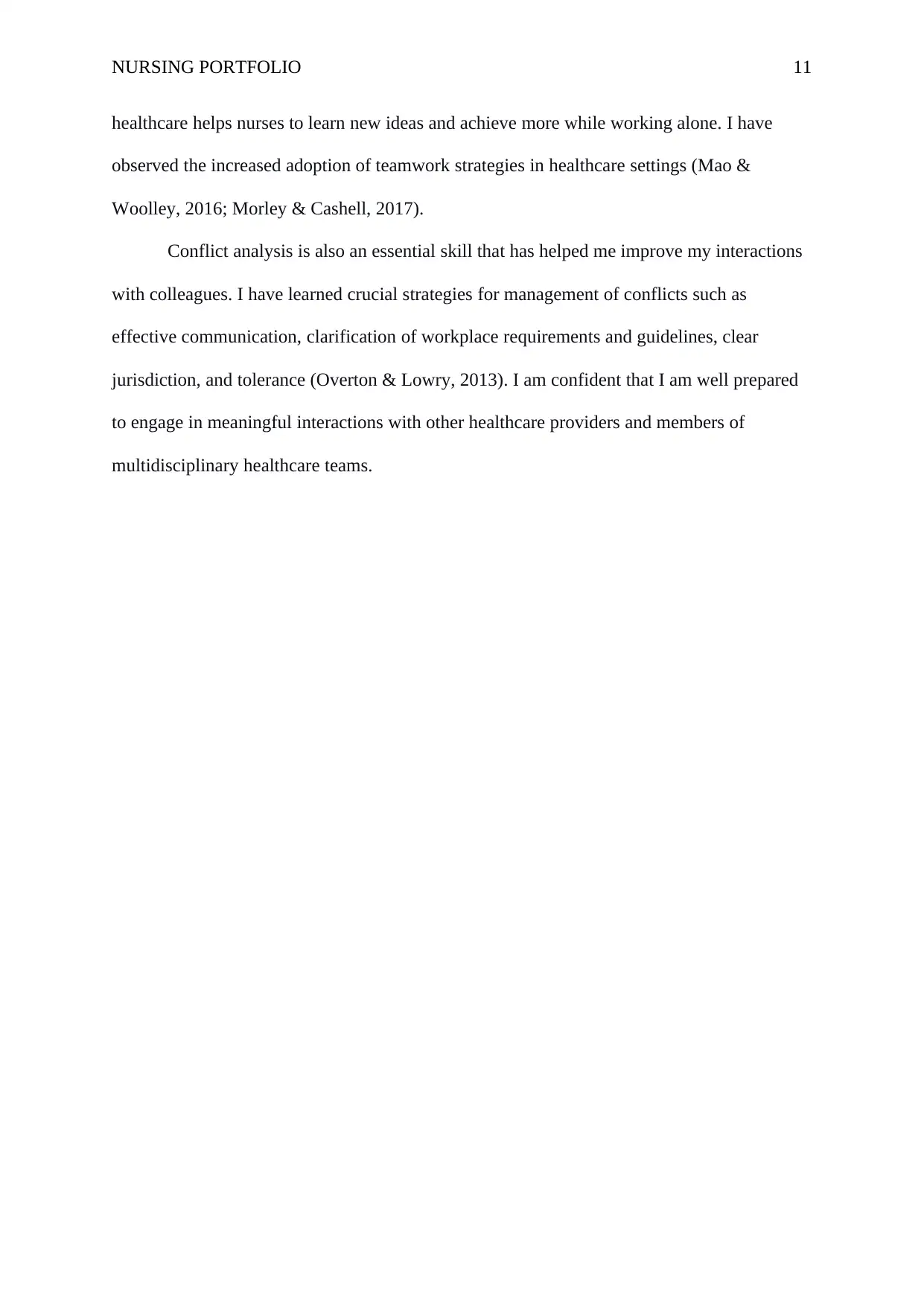
NURSING PORTFOLIO 11
healthcare helps nurses to learn new ideas and achieve more while working alone. I have
observed the increased adoption of teamwork strategies in healthcare settings (Mao &
Woolley, 2016; Morley & Cashell, 2017).
Conflict analysis is also an essential skill that has helped me improve my interactions
with colleagues. I have learned crucial strategies for management of conflicts such as
effective communication, clarification of workplace requirements and guidelines, clear
jurisdiction, and tolerance (Overton & Lowry, 2013). I am confident that I am well prepared
to engage in meaningful interactions with other healthcare providers and members of
multidisciplinary healthcare teams.
healthcare helps nurses to learn new ideas and achieve more while working alone. I have
observed the increased adoption of teamwork strategies in healthcare settings (Mao &
Woolley, 2016; Morley & Cashell, 2017).
Conflict analysis is also an essential skill that has helped me improve my interactions
with colleagues. I have learned crucial strategies for management of conflicts such as
effective communication, clarification of workplace requirements and guidelines, clear
jurisdiction, and tolerance (Overton & Lowry, 2013). I am confident that I am well prepared
to engage in meaningful interactions with other healthcare providers and members of
multidisciplinary healthcare teams.
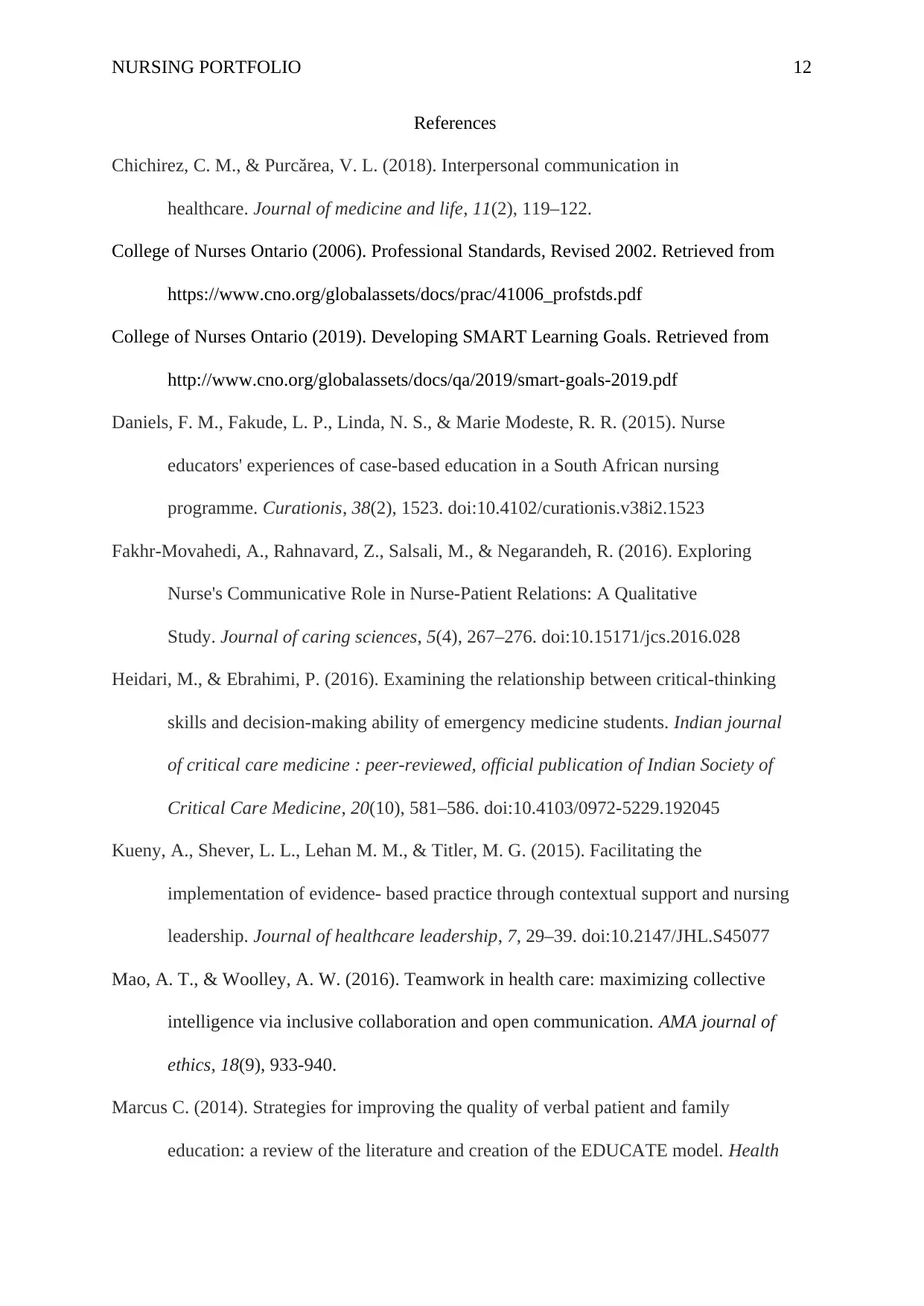
NURSING PORTFOLIO 12
References
Chichirez, C. M., & Purcărea, V. L. (2018). Interpersonal communication in
healthcare. Journal of medicine and life, 11(2), 119–122.
College of Nurses Ontario (2006). Professional Standards, Revised 2002. Retrieved from
https://www.cno.org/globalassets/docs/prac/41006_profstds.pdf
College of Nurses Ontario (2019). Developing SMART Learning Goals. Retrieved from
http://www.cno.org/globalassets/docs/qa/2019/smart-goals-2019.pdf
Daniels, F. M., Fakude, L. P., Linda, N. S., & Marie Modeste, R. R. (2015). Nurse
educators' experiences of case-based education in a South African nursing
programme. Curationis, 38(2), 1523. doi:10.4102/curationis.v38i2.1523
Fakhr-Movahedi, A., Rahnavard, Z., Salsali, M., & Negarandeh, R. (2016). Exploring
Nurse's Communicative Role in Nurse-Patient Relations: A Qualitative
Study. Journal of caring sciences, 5(4), 267–276. doi:10.15171/jcs.2016.028
Heidari, M., & Ebrahimi, P. (2016). Examining the relationship between critical-thinking
skills and decision-making ability of emergency medicine students. Indian journal
of critical care medicine : peer-reviewed, official publication of Indian Society of
Critical Care Medicine, 20(10), 581–586. doi:10.4103/0972-5229.192045
Kueny, A., Shever, L. L., Lehan M. M., & Titler, M. G. (2015). Facilitating the
implementation of evidence- based practice through contextual support and nursing
leadership. Journal of healthcare leadership, 7, 29–39. doi:10.2147/JHL.S45077
Mao, A. T., & Woolley, A. W. (2016). Teamwork in health care: maximizing collective
intelligence via inclusive collaboration and open communication. AMA journal of
ethics, 18(9), 933-940.
Marcus C. (2014). Strategies for improving the quality of verbal patient and family
education: a review of the literature and creation of the EDUCATE model. Health
References
Chichirez, C. M., & Purcărea, V. L. (2018). Interpersonal communication in
healthcare. Journal of medicine and life, 11(2), 119–122.
College of Nurses Ontario (2006). Professional Standards, Revised 2002. Retrieved from
https://www.cno.org/globalassets/docs/prac/41006_profstds.pdf
College of Nurses Ontario (2019). Developing SMART Learning Goals. Retrieved from
http://www.cno.org/globalassets/docs/qa/2019/smart-goals-2019.pdf
Daniels, F. M., Fakude, L. P., Linda, N. S., & Marie Modeste, R. R. (2015). Nurse
educators' experiences of case-based education in a South African nursing
programme. Curationis, 38(2), 1523. doi:10.4102/curationis.v38i2.1523
Fakhr-Movahedi, A., Rahnavard, Z., Salsali, M., & Negarandeh, R. (2016). Exploring
Nurse's Communicative Role in Nurse-Patient Relations: A Qualitative
Study. Journal of caring sciences, 5(4), 267–276. doi:10.15171/jcs.2016.028
Heidari, M., & Ebrahimi, P. (2016). Examining the relationship between critical-thinking
skills and decision-making ability of emergency medicine students. Indian journal
of critical care medicine : peer-reviewed, official publication of Indian Society of
Critical Care Medicine, 20(10), 581–586. doi:10.4103/0972-5229.192045
Kueny, A., Shever, L. L., Lehan M. M., & Titler, M. G. (2015). Facilitating the
implementation of evidence- based practice through contextual support and nursing
leadership. Journal of healthcare leadership, 7, 29–39. doi:10.2147/JHL.S45077
Mao, A. T., & Woolley, A. W. (2016). Teamwork in health care: maximizing collective
intelligence via inclusive collaboration and open communication. AMA journal of
ethics, 18(9), 933-940.
Marcus C. (2014). Strategies for improving the quality of verbal patient and family
education: a review of the literature and creation of the EDUCATE model. Health
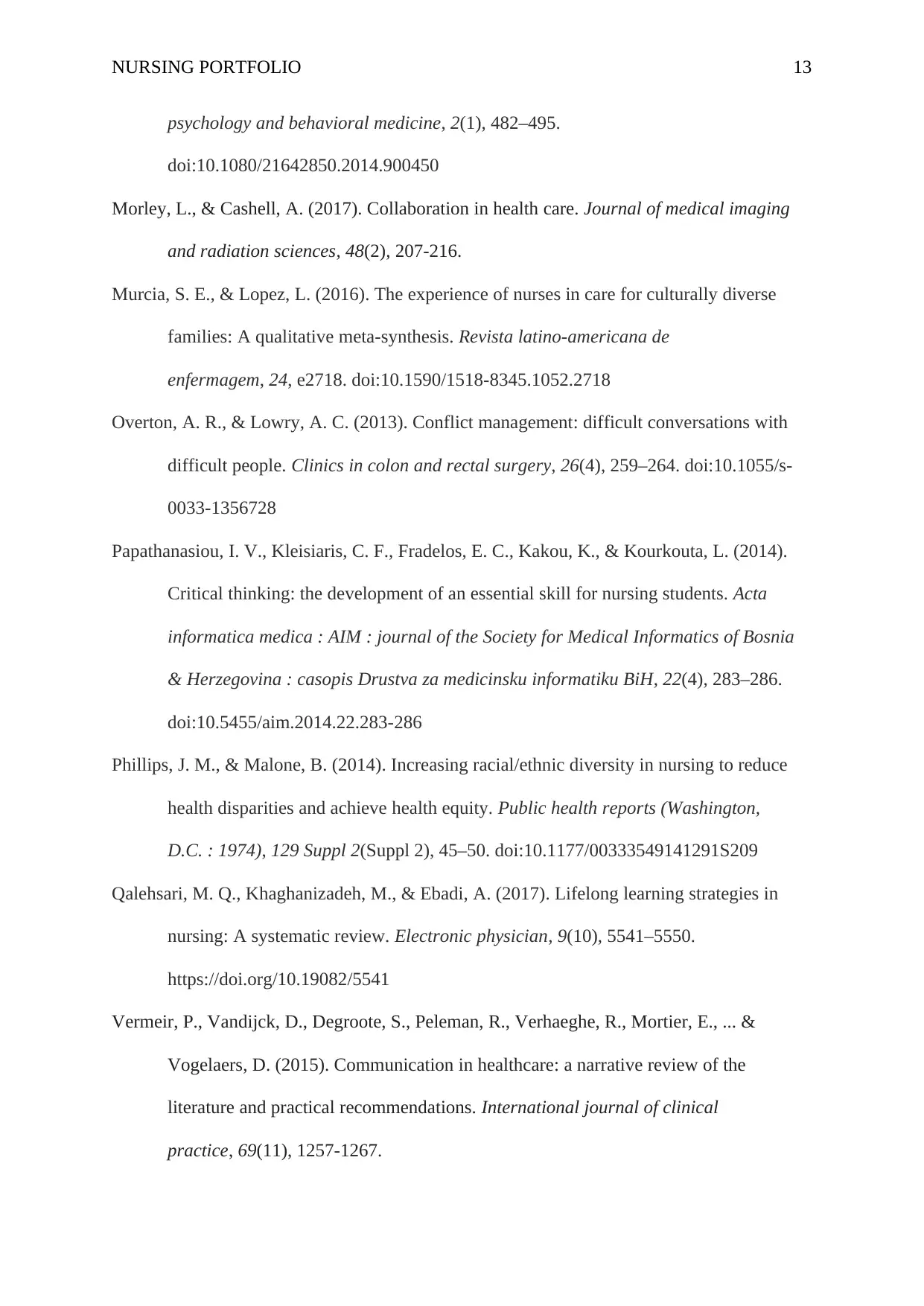
NURSING PORTFOLIO 13
psychology and behavioral medicine, 2(1), 482–495.
doi:10.1080/21642850.2014.900450
Morley, L., & Cashell, A. (2017). Collaboration in health care. Journal of medical imaging
and radiation sciences, 48(2), 207-216.
Murcia, S. E., & Lopez, L. (2016). The experience of nurses in care for culturally diverse
families: A qualitative meta-synthesis. Revista latino-americana de
enfermagem, 24, e2718. doi:10.1590/1518-8345.1052.2718
Overton, A. R., & Lowry, A. C. (2013). Conflict management: difficult conversations with
difficult people. Clinics in colon and rectal surgery, 26(4), 259–264. doi:10.1055/s-
0033-1356728
Papathanasiou, I. V., Kleisiaris, C. F., Fradelos, E. C., Kakou, K., & Kourkouta, L. (2014).
Critical thinking: the development of an essential skill for nursing students. Acta
informatica medica : AIM : journal of the Society for Medical Informatics of Bosnia
& Herzegovina : casopis Drustva za medicinsku informatiku BiH, 22(4), 283–286.
doi:10.5455/aim.2014.22.283-286
Phillips, J. M., & Malone, B. (2014). Increasing racial/ethnic diversity in nursing to reduce
health disparities and achieve health equity. Public health reports (Washington,
D.C. : 1974), 129 Suppl 2(Suppl 2), 45–50. doi:10.1177/00333549141291S209
Qalehsari, M. Q., Khaghanizadeh, M., & Ebadi, A. (2017). Lifelong learning strategies in
nursing: A systematic review. Electronic physician, 9(10), 5541–5550.
https://doi.org/10.19082/5541
Vermeir, P., Vandijck, D., Degroote, S., Peleman, R., Verhaeghe, R., Mortier, E., ... &
Vogelaers, D. (2015). Communication in healthcare: a narrative review of the
literature and practical recommendations. International journal of clinical
practice, 69(11), 1257-1267.
psychology and behavioral medicine, 2(1), 482–495.
doi:10.1080/21642850.2014.900450
Morley, L., & Cashell, A. (2017). Collaboration in health care. Journal of medical imaging
and radiation sciences, 48(2), 207-216.
Murcia, S. E., & Lopez, L. (2016). The experience of nurses in care for culturally diverse
families: A qualitative meta-synthesis. Revista latino-americana de
enfermagem, 24, e2718. doi:10.1590/1518-8345.1052.2718
Overton, A. R., & Lowry, A. C. (2013). Conflict management: difficult conversations with
difficult people. Clinics in colon and rectal surgery, 26(4), 259–264. doi:10.1055/s-
0033-1356728
Papathanasiou, I. V., Kleisiaris, C. F., Fradelos, E. C., Kakou, K., & Kourkouta, L. (2014).
Critical thinking: the development of an essential skill for nursing students. Acta
informatica medica : AIM : journal of the Society for Medical Informatics of Bosnia
& Herzegovina : casopis Drustva za medicinsku informatiku BiH, 22(4), 283–286.
doi:10.5455/aim.2014.22.283-286
Phillips, J. M., & Malone, B. (2014). Increasing racial/ethnic diversity in nursing to reduce
health disparities and achieve health equity. Public health reports (Washington,
D.C. : 1974), 129 Suppl 2(Suppl 2), 45–50. doi:10.1177/00333549141291S209
Qalehsari, M. Q., Khaghanizadeh, M., & Ebadi, A. (2017). Lifelong learning strategies in
nursing: A systematic review. Electronic physician, 9(10), 5541–5550.
https://doi.org/10.19082/5541
Vermeir, P., Vandijck, D., Degroote, S., Peleman, R., Verhaeghe, R., Mortier, E., ... &
Vogelaers, D. (2015). Communication in healthcare: a narrative review of the
literature and practical recommendations. International journal of clinical
practice, 69(11), 1257-1267.
1 out of 13
Related Documents
Your All-in-One AI-Powered Toolkit for Academic Success.
+13062052269
info@desklib.com
Available 24*7 on WhatsApp / Email
![[object Object]](/_next/static/media/star-bottom.7253800d.svg)
Unlock your academic potential
© 2024 | Zucol Services PVT LTD | All rights reserved.





